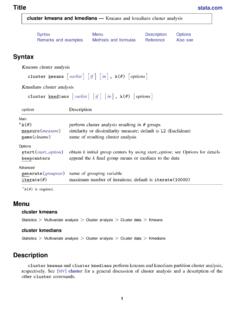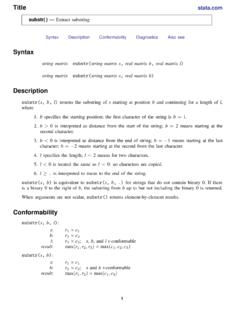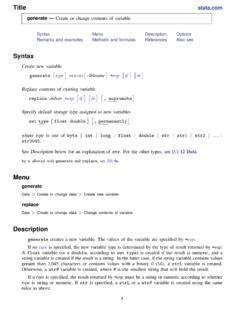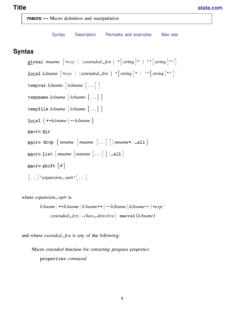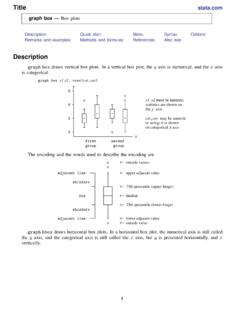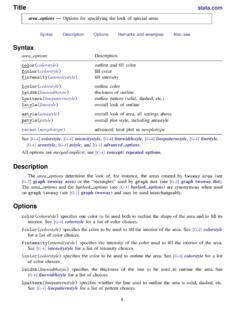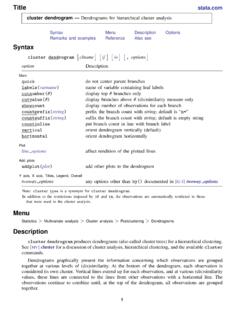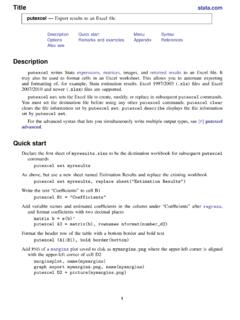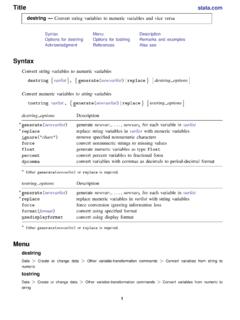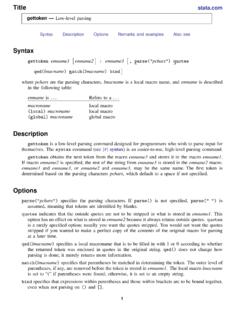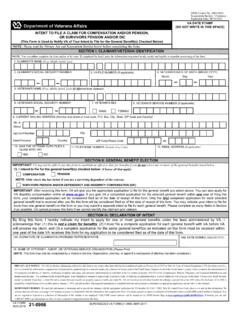Transcription of Title stata.com preserve — Preserve and restore data
1 Preserve and restore dataDescriptionSyntaxOptionsRemarks and examplesAlso seeDescriptionpreservepreserves the data , guaranteeing that data will be restored after program a restore of the data maxpreservemem, available only in Stata/MP, controls the maximum amount of memorypreservewill use to store preserved datasets in memory. Once this limit is exceeded,preservewill store datasets on datapreserve[, changed] restore datarestore[, not Preserve ]Set maximum memory for fast storage bypreserveset maxpreservememamt[, permanently]whereamtis#[b|k|m|g], and the default unit Preserve only the flag indicating that the data have changed sincethe last save. Use of this option is strongly discouraged, as explained in the technical note cancel the restore the data now, but not to cancel the restoration of the dataagain at program conclusion.
2 Ifpreserveis not specified, the scheduled restoration at programconclusion is maxpreservememthat, in addition to making the change right now,the new limit be remembered and become the default setting when you invoke not shown in the syntax diagram but is allowed withset maxpreservemem. It is for use bysystem administrators and allows them to setmaxpreservememsuch that users cannot modifyit; seeNotes for system administratorsin [D] Preserve Preserve and restore dataRemarks and with the programming problem where the user s data must be changedto achieve the desired result but, when the program concludes, the programmer wishes to undo thedamage done to the data . Whenpreserveis issued, the user s data are preserved.
3 The data inmemory remain unchanged. When the program or do-file concludes, the user s data are apreserve, the programmer can also instruct Stata to restore the data now with therestorecommand. This is useful when the programmer needs the original data back and knows that no moredamage will be done to the , preservecan be used when the programmer needs thedata back but plans further , notcan be used when the programmer wishes tocancel the previouspreserveand to have the data currently in memory returned to the speed, Stata/MP usesframesto Preserve datasets to memory rather than writing them to does so unless themaxpreservememlimit has been reached in terms of memory consumed bypreserved datasets.
4 Once the limit has been reached, Stata/MP falls back to writing preserved datasetsto disk. Stata/SE and Stata/BE are typically used on computers with less memory and as such alwayspreserve datasets on default setting forset maxpreservememis1g, meaning 1 gigabyte. Ifamtis set to0b(0 bytes),preservewill always use disk storage. Ifamtis set to.,preservewill use as muchmemory as the operating system is willing to supply. The memory used bypreserveis in addition tothe memory used by other datasets you may have in memory and is not included in yourmaxmemorysetting (see [D]memory). Keep this in mind when changing this 1preserveis usually used by itself and is used early in the program. Say that a programmer iswriting a program to report some statistic, but the statistic cannot be calculated without changing theuser s data .
5 Here changing does not mean merely adding a variable or two; that could be done withtemporary variables as described in [P]macro. Changing means that the data really must be changed:observations might be discarded, the contents of existing variables changed, and the like. Althoughthe programmer could just ignore the destruction of the user s data , the programmer might actuallywant to use the program herself and knows that she will become exceedingly irritated when she usesit without remembering to first save her data . The programmer wishes to write a programmaticallycorrect, orPC, command. Doing so is not difficult:programmyprog(code for interpreting parsing the user s request) Preserve (code that destroys the data )(code that makes the calculation)(code that reports the result)endTo Preserve the data ,preservemust make a copy of it on disk.
6 Therefore, our programmer smartlyperforms all the parsing and setup, where errors are likely, before thepreserve. Once she gets tothe point in the code where the damage must be done, however, she preserves the data . After that,she forgets the problem. Stata handles restoring the user s data , even if the user pressesBreakin themiddle of the Preserve and restore data 3 Example 2 Now let s consider a program that must destroy the user s data but needs the data back again, and,once the data are recovered, will do no more damage. The outline isprogrammyprog(code for interpreting parsing the user s request) Preserve (code that destroys the data )(code that makes the first part of the calculation) restore (code that makes the second part of the calculation)(code that reports the result)endAlthough there are other ways the programmer could have arranged to save the data and get the databack [snapshot(see [D]snapshot)]
7 Orsaveandusewith temporary files as described in [P]macrocome to mind], this method is better because should the user pressBreakafter the data are damagedbut before the data are restored, Stata will handle restoring the 3 This time the program must destroy the user s data , bring the data back and destroy the data again,and finally report its calculation. The outline isprogrammyprog(code for interpreting parsing the user s request) Preserve (code that destroys the data )(code that makes the first part of the calculation) restore , Preserve (code that makes the second part of the calculation)(code that reports the result)endThe programmer could also have coded arestoreon one line and apreserveon the next. Itwould have the same result but would be inefficient, because Stata would then rewrite the data , preservetells Stata to reload the data but to leave the copy on disk for 4A programmer is writing a program that intends to change the user s data in memory the damagethe programmer is about to do is not damage at all.
8 Nevertheless, if the user pressedBreakwhile theprogrammer was in the midst of the machinations, what would be left in memory would be programmatically correct outline isprogrammyprog(code for interpreting parsing the user s request) Preserve (code that reforms the data ) restore , notend4 Preserve Preserve and restore dataBefore undertaking the reformation, the programmer smartly preserves the data . When everything iscomplete, the programmer cancels the restoration by typingrestore, noteWe said above that withset maxpreservemem, if you setamtto0b(0 bytes),preservewilluse disk storage. In fact, if you setamtto anything less than the size of one of Stata s data segments(seeset segmentsizein [D]memory),preservewill always use disk storage.
9 You can typequerymemoryto see the notepreserve, changedis best avoided, although it is very , changeddoes notpreserve the data ; it merely records whether the data have changed since the data were last saved (asmentioned bydescribeand as checked byexitandusewhen the user does not also sayclear)and restores the flag at the conclusion of the program. The programmer must ensure that the datareally have not long as the programs use temporary variables, as created bytempvar(see [P]macro), thechanged-since-last-saved flag would not be changed anyway Stata can track such temporary changesto the data that it will, itself, be able to undo. In fact, we cannot think of one use forpreserve,changed, and included it only to Preserve the happiness of our more imaginative see[P]nopreserve option nopreserve option[D]snapshot Save and restore data snapshots[P]macro Macro definition and manipulatio
